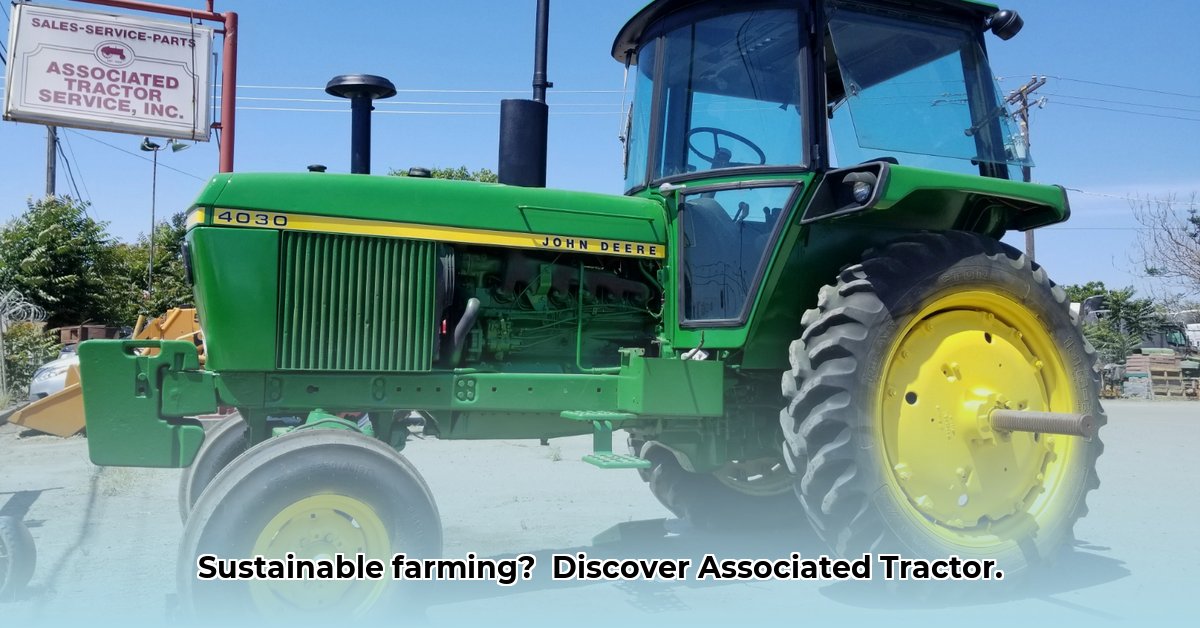
ATS: A Legacy in the Fields, a Future in Sustainability?
Since 1954, Associated Tractor Service (ATS) has been a fixture in the agricultural landscape, witnessing firsthand the evolution of farming technology. Their core business—the buying, selling, and servicing of pre-owned tractors and parts—positions them uniquely within a growing conversation about sustainable agriculture. But how does ATS's business model truly align with the increasing demand for environmentally responsible practices within the used equipment market? This article explores the complexities of sustainability in the used agricultural machinery sector, examining both the potential benefits and the inherent challenges, using ATS as a case study. For smaller farms, consider renting a small tractor.
The Used Tractor Market: Balancing Budgets and the Environment
The appeal of used tractors is undeniable: significantly lower upfront costs compared to new machinery, making them an attractive option for smaller farms and those facing budget constraints. This financial advantage, however, presents a critical environmental question: What is the true environmental cost of operating older, less fuel-efficient machinery? Older tractors often consume more fuel, impacting carbon emissions, while their components may contain materials that are difficult and costly to recycle responsibly. This raises concerns about the long-term environmental impact of this cost-effective approach to acquiring farm equipment. Can companies like ATS effectively mitigate these risks?
Transparency: The Cornerstone of Sustainable Practices
Currently, ATS' website lacks detailed information regarding their refurbishment processes and waste management practices. This lack of transparency hinders a comprehensive assessment of their environmental footprint. Imagine if ATS comprehensively detailed the refurbishment of each tractor—the specific parts replaced, the materials used, and the ultimate destination of discarded components. Such openness would build customer trust and facilitate informed, environmentally conscious purchasing decisions. A clear picture of ATS's sustainability efforts is crucial for environmentally conscious farmers.
Consider a hypothetical scenario: A farmer weighs the options of a new tractor versus a meticulously refurbished model from ATS. If ATS provided transparent information on the used tractor’s history—usage, maintenance records, and refurbishment specifics—the farmer could make a thoroughly informed decision, potentially choosing the used option as the more sustainable choice. This enhanced transparency is a critical element in fostering sustainability within the used equipment market.
A Path Towards a Greener Future: Collaborative Action
Building a truly sustainable used agricultural equipment market requires concerted action from multiple stakeholders:
ATS's Responsibility: ATS can significantly enhance its commitment to sustainability through:
- Website Enhancement: Providing detailed information on each tractor's history, refurbishment, and parts sourcing.
- Waste Management Transparency: Publicly disclosing their responsible disposal methods, including partnerships with certified recycling facilities.
- Industry Certifications: Obtaining relevant certifications demonstrating dedication to environmental stewardship, boosting consumer confidence and attracting environmentally conscious clientele.
Farmers as Environmental Stewards: Farmers can play an active role in choosing sustainability by:
- Total Cost Analysis: Carefully evaluating the total cost of ownership (TCO), encompassing fuel, maintenance, and potential repairs, to identify the most cost-effective and environmentally sound option.
- Leasing as an Alternative: Exploring equipment leasing as a more sustainable strategy, allowing for upgrades to more fuel-efficient models as technology evolves and minimizing the environmental burden of older machinery.
Governmental Regulation and Incentives: Governments and regulatory bodies can contribute through:
- Clear Disposal Guidelines: Establishing and enforcing strict environmental guidelines for the disposal of agricultural machinery and its components, focusing on safe handling of hazardous materials.
- Financial Incentives: Offering incentives, such as tax breaks or grants, to companies adopting and maintaining environmentally friendly practices.
The Crucial Role of Research: Independent research is vital for:
- Lifecycle Assessments: Conducting comprehensive lifecycle assessments of used agricultural machinery to determine their environmental impact throughout their entire lifespan.
- Standardized Sustainability Metrics: Developing standardized metrics to assess the sustainability of different equipment management approaches, allowing for objective comparisons.
Mitigating Risks: A Proactive Approach
| Risk Factor | Likelihood | Impact | Mitigation Strategy |
|---|---|---|---|
| Improper Waste Disposal | Medium to High | High | Strategic partnerships with certified recyclers; rigorous internal waste management processes. |
| Lack of Equipment History | High | Medium | Robust equipment history and maintenance record tracking; readily available customer access to this information. |
| Mechanical Failures | Medium | Medium to High | Thorough pre-sale inspections; extended warranties or service contracts; comprehensive employee training. |
| Intense Competition | High | Medium | Highlighting cost savings and environmental benefits; flexible financing; strong customer relationships. |
Navigating the Regulatory Landscape: Adapting to Change
The regulatory landscape is dynamic. New regulations regarding hazardous material disposal and stricter emission standards are likely. ATS must proactively adapt to these changes, not merely for compliance, but to maintain a positive reputation and attract environmentally conscious customers.
Conclusion: A Sustainable Future for Farming
The used farm equipment market, with key players like ATS, is vital to modern agriculture. However, true sustainability demands transparency, eco-conscious practices, and collaborative action. Balancing profitability with environmental responsibility is paramount for the future of sustainable agriculture. This requires continuous research, adaptive strategies, and a collective commitment to improvement. The future of farming depends on it.